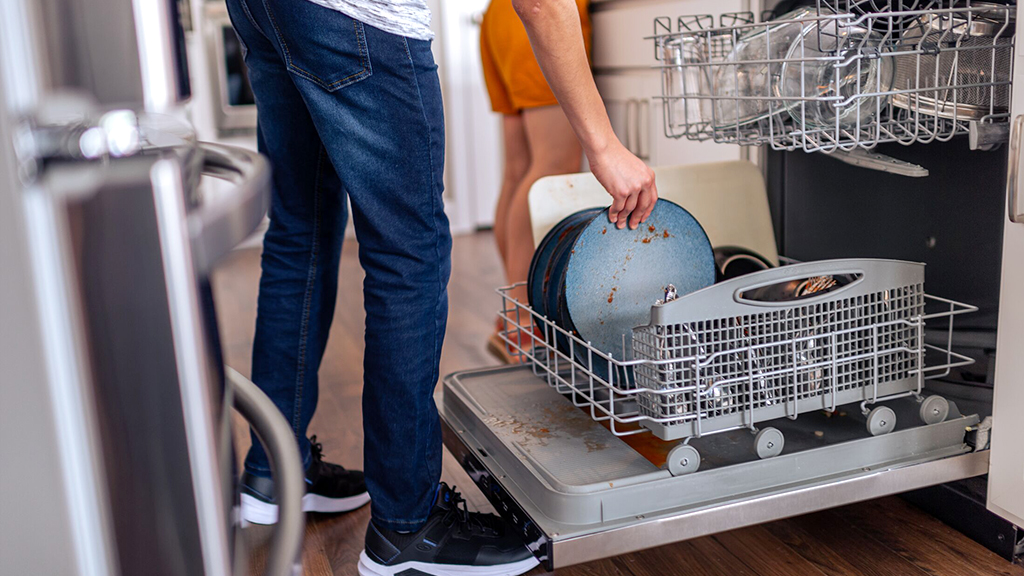When you unload your dishwasher, do you notice small pieces of last night's dinner still stuck on the plates and bowls? There are lots of reasons this might happen, from a dirty filter to a broken soap dispenser. Whatever the reason, your dishwasher is not cleaning the way it should, and we can help.
At Asurion, we don't just fix appliances, we fix the frustration you feel when yours don't work—whether it's a dishwasher door that won't close or a refrigerator that's too cold. Here's what our experts suggest you do when your dishwasher is not cleaning well.
Reasons your dishwasher isn't cleaning dishes
There are a handful of common issues that could prevent your dishwasher from cleaning properly, including:
- A dirty interior from food deposits.
- Poor quality detergent.
- Your water temperature.
- A busted soap dispenser.
- A dirty filter.
- A clogged spray arm.
- A broken inlet valve.
- Hard water.
Before we take a look at each one and its potential solution, here are two important reminders:
- Always turn off the power on your dishwasher before trying to fix it.
- Keep your user's manual handy to assist you as you troubleshoot.
A dirty interior from food deposits
Small bits of food, grease, and soap scum can build up inside your dishwasher, preventing it from doing its job. If your dishes aren't spotless, the first step is to clean the interior of your machine.
Pour 3 cups of white vinegar in the bottom and run a full wash cycle. The vinegar helps remove gunk from the holes in the spray arm, dissolves light mineral buildup, and cleans grease from the interior walls. Your dishes may even smell better too.
Poor quality detergent
Another potential cause of a dishwasher not cleaning dishes is substandard detergent—or too much detergent. Check your manual to ensure you're using the right kind and amount. You can also use a rinse agent, which helps your dishes dry faster, preventing spots from forming.
Water temperature
The water in your dishwasher should reach at least 120 degrees Fahrenheit to clean dishes properly. Some dishwashers automatically heat water to this ideal temperature. If yours doesn't, check that the water heater is set as close to 120 degrees as possible—any higher and it could get dangerously hot.
You can also turn on the kitchen sink for a minute before running the dishwasher to help ensure hot water flows into the machine from the very start of the wash cycle.

No one wants to deal with a broken appliance
With Asurion Appliance+, you don’t have to. Our hassle-free plans cover all your eligible home appliances—no matter the brand or where you bought them.
A busted soap dispenser
A faulty soap dispenser may also be the issue. Often caused by a jammed dispenser door spring, this glitch can prohibit detergent from releasing at the proper time during the wash cycle. To fix it, mix hot water and vinegar and use the solution along with a small brush to clean gunk and grease off the springs and soap dispenser. Check out our guide to fixing soap dispensing issues for more details.
If your spring or dispenser door is broken, it will have to be replaced. And if the gasket around the dispenser is cracked, you'll need to replace that too.
A dirty filter
Older dishwashers (pre-2010) come with a self-cleaning filter, but newer models have removable ones that can get clogged with small pieces of food if you don't clean your filter every month or two. Here's how:
- Locate the filter under the racks and remove it from the machine (you may have to twist off the cap first).
- Rinse it under hot running water, and if you see gunk and grime stuck to the filter, let it sit in soapy hot water for a few minutes or overnight in vinegar.
- Scrub it with an old toothbrush, rinse, and reinstall.
A clogged spray arm
In your washer, there are spinning spray arms that shoot water through tiny holes, called jets, to clean your dishes. If the jets are clogged, the water pressure suffers.
- Detach the spray arm (check your user's manual to find out if it snaps off or requires you to remove a screw), then scrub it with a soft brush and dish soap.
- Use a toothpick to unclog the holes.
- Run hot water over the spray arm.
It's a good idea to spin the spray arms yourself to confirm they're rotating fluidly. If you notice something blocking them, remove it and try again.
A broken inlet valve
If you've tried the previous tips and your dishwasher still isn't cleaning well, you could have a problem with the inlet valve. That's the part that enables water to flow into the machine. Another sign your inlet valve is busted: You hear a hammering noise during the wash cycle. Fixing it can be complicated, so check your owner's manual to see if you want to order and install a replacement or contact an expert.
Hard water
If the water in your home leaves a chalky residue on whatever it touches, you have hard water—H20 that's filled with a lot of minerals, like calcium and magnesium. Hard water can also leave residue inside your dishwasher, affecting its efficiency and lifespan. The best thing to do is install a water softener on the water line coming into your home to help control the damage from mineral deposits.
Reliable protection for the major appliances you rely on
When your appliances don't work, we do. With Asurion Appliance+®, get hassle-free coverage for your current appliances and future purchases—no matter the brand or where you bought them—plus 24/7 troubleshooting support. Learn more about Asurion Appliance+™ coverage and how you can get total peace of mind protection.





